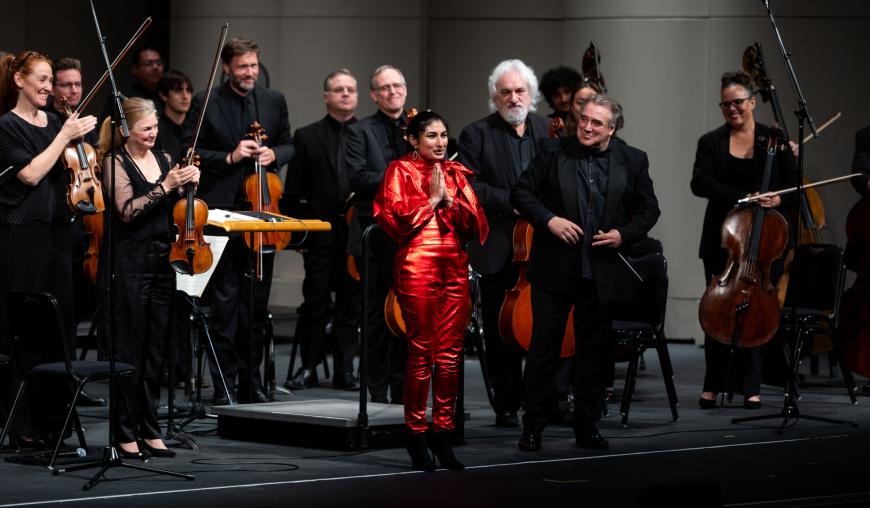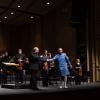
Los Angeles Chamber Orchestra’s 2023–2024 season concluded in Glendale’s Alex Theatre on Saturday, May 25 with a traditional three-part program. The orchestra played its last concert in the acoustically superior Royce Hall in April, and next season, it will stay in the Alex and move to the much smaller venue of The Wallis, a space with not terribly inviting acoustics, for its Westside audience.
But if one reason for leaving Royce Hall — besides the exorbitantly rising rental charges — was the large number of empty seats, the orchestra didn’t exactly fill the Alex on this Memorial Day weekend evening either.
The concert began with the latest of LACO’s Sound Investment world premieres to savor, Nina Shekhar’s Glitter Monster. The composer, Indian American by way of Detroit, writes that her new 15½-minute work “imagines a surreal world where bright is dark, psychedelic is sane, giggles are screams, and princesses are warriors. Or maybe this bedazzled fantasy is already reality.”

Sure, but better to concentrate on the title itself in order to grasp the piece, and that wasn’t hard.
A Nord synthesizer buried toward the rear of the orchestra launched Glitter Monster with some electronic ringing sounds, soon joined by harp, bowed crotales, and mallet percussion. This must be the glitter that permeates most of the piece. Eventually, the rest of the chamber orchestra fell in with a crescendo presumably representing the monster, which then faded, leaving the glitter in place in the form of scales in the winds. Next came a lovely dreamscape that was soon pared down to a single violin line before the glitter resumed at a low volume. The monster seemed to have gone away, leaving a rather attractive set of sonorities in place. This is a piece well worth hearing again.
One-of-a-kind Venezuelan pianist Gabriela Montero said that she had not performed in Los Angeles for several years. I haven’t encountered her since she was playing regularly at the Hollywood Bowl with the Los Angeles Philharmonic over a decade ago. Whatever the cause of her absence, the world knows that Montero has been very critical of the Nicolás Maduro-led government in Venezuela and that she forcefully urged the LA Phil’s then-neutral Gustavo Dudamel to confront Maduro, which the conductor eventually did, at the cost of virtual exile.

With LACO, Montero performed Mozart’s moody Piano Concerto No. 24 in C Minor, K. 491. She kept a mostly gentle yet firm touch, with Music Director Jaime Martín maintaining a flowing accompaniment. The fast runs in the finale were effortlessly clear, and there were glimpses of vehement power in a variation or two.
As an encore, Montero demonstrated her extraordinary (and still rare) ability to improvise in a classical context. She asked members of the audience to sing or hum a phrase that she would then expand upon. Somebody bellowed out the opening of Beethoven’s Fifth Symphony, and Montero proceeded to spool out an ingenious lyrical fantasy on the theme, with pastiches of Frédéric Chopin in three-quarter time, Niccolò Paganini’s Caprice No. 24, a little J.S. Bach, a habanera, and finally a circusy Latin rhythm veering close to the tune “Tico-Tico.”
(With a quick reference to an old review of mine, I confirmed that Montero did much the same thing with the Beethoven Fifth motto at the Hollywood Bowl in 2010, right down to the “Tico-Tico” rhythm. So it’s hard to say whether this was entirely spontaneous, but it was still a wow moment that got a bigger hand from the audience than the concerto.)

To close the concert and season, Martín set out on Franz Schubert’s sprawling Symphony No. 9 by getting a deep, satisfyingly rich tone out of the four-person cello section in the introduction and pumping up the main tempo from Allegro ma non troppo to Molto allegro. Everything else was pretty much within the standard parameters of tempo for this work.
What the performance lacked in absolute precision, it made up for in raw guts and punch. However, as the repetitions of the finale added up, the orchestra ran low on fuel. Maybe the players were tiring — and if so, one can understand. This was a relatively long evening of music, ending with a 50-minute symphony that, as Allan Sherman parodied in his “The End of a Symphony” comedy bit from the 1960s, doesn’t quite know when to sign off.




